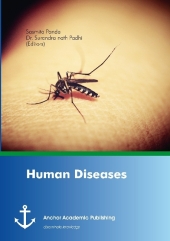 Neuerscheinungen 2017Stand: 2020-02-01 |
Schnellsuche
ISBN/Stichwort/Autor
|
Herderstraße 10
10625 Berlin
Tel.: 030 315 714 16
Fax 030 315 714 14
info@buchspektrum.de |

Surendra nath Padhi, Sasmita Panda
(Beteiligte)
Human Diseases
Herausgegeben von Panda, Sasmita; Padhi, Surendra nath
2017. 152 S. 32 Abb. 270 mm
Verlag/Jahr: ANCHOR ACADEMIC PUBLISHING 2017
ISBN: 3-9606717-4-1 (3960671741)
Neue ISBN: 978-3-9606717-4-9 (9783960671749)
Preis und Lieferzeit: Bitte klicken
This book on "Human Diseases" is written with a view to meet curricular requirements of students at undergraduate and post graduate levels of Indian Universities. Diseases are illnesses impairing the normal physiological functioning of living organisms. The causative agents are virus, bacteria, protozoans, helminthes and others. The diseases chosen for this book are: measles, smallpox, chickenpox, AIDS, Ebola, Dengue, cholera, leprosy, tuberculosis, typhoid, malaria, amoebiasis, Diarrhoea, Filariasis, Cancer and Jaundice. The text describes causative agents, signs and symptoms, diagnosis, prevention, treatment, epidemiology and history of all 16 diseases. A table containing these factors has also been included for the convenience of readers to have an immediate idea about these human diseases.
Text Sample:
Chapter 2: SMALLPOX:
By Sasmita Panda.
2.1. INTRODUCTION:
Smallpox is an extremely contagious and deadly viral disease caused by Variola virus for which there is no known cure. The last known case occurred in the United States in 1949 and due to worldwide vaccination programs, this disease has been completely eradicated. Smallpox is also known as variola. Since the time of ancient Egypt, smallpox has proven to be one of the most devastating diseases to humankind. Widespread smallpox epidemics and huge death tolls fill the pages of our history books. The first smallpox vaccine was created in 1758. However, the disease continued to infect and kill people on a widespread basis for another 200 years. The World Health Organization (WHO) implemented a strict vaccination standard in order to slow the infection rate. The last known natural case occurred in 1977 in Somalia. By 1980, the WHO declared that smallpox had been completely eradicated, although Government and health agencies still have stashes of smallpox virus for research purposes. People no longer receive routine smallpox vaccinations. The smallpox vaccine can have potentially fatal side effects, so only the people who are at high risk of exposure get the vaccine.
2.2. SYMPTOMS:
Historical accounts show that when someone was infected with the smallpox virus, they had no symptoms for between seven and 17 days. However, once the incubation period (or virus development phase) was over, the following flu-like symptoms occurred:
High fever.
Chills.
Headache.
Severe back pain.
Abdominal pain.
Vomiting.
These symptoms would go away within two to three days. Then the patient would feel better. However, just as the patient started to feel better, a rash would appear. The rash started on the face and then spread to the hands, forearms, and the main part of the body. The person would be highly contagious until the rash disappeared.
Within two days of appearance, the rash would develop into abscesses that filled with fluid and pus. The abscesses would break open and scab over. The scabs would eventually fall off, leaving pit mark scars. Until the scabs fell off, the person remained contagious.
2.3. COMPLICATIONS:
Complications of smallpox arise most commonly in the respiratory system and range from simple bronchitis to fatal pneumonia. Respiratory complications tend to develop on about the eighth day of the illness and can be either viral or bacterial in origin. Secondary bacterial infection of the skin is a relatively uncommon complication of smallpox. When this occurs, the fever usually remains elevated.
Other complications include encephalitis (1 in 500 patients), which is more common in adults and may cause temporary disability; permanent pitted scars, most notably on the face; and complications involving the eyes (2 percent of all cases). Pustules can form on the eyelid, conjunctiva, and cornea, leading to complications such as conjunctivitis, keratitis, corneal ulcer, iritis, iridocyclitis, and optic atrophy. Blindness results in approximately 35 percent to 40 percent of eyes affected with keratitis and corneal ulcer. Haemorrhagic smallpox can cause subconjunctival and retinal haemorrhages. In 2 to 5 percent of young children with smallpox, virions reach the joints and bone, causing osteomyelitis variolosa. Lesions are symmetrical, most common in the elbows, tibia, and fibula, and characteristically cause separation of an epiphysis and marked periosteal reactions. Swollen joints limit movement, and arthritis may lead to limb deformities, ankylosis, malformed bones, flail joints, and stubby fingers.
2.4. CAUSE:
One of the reasons smallpox was so dangerous and deadly is because it´s an airborne disease. Airborne diseases tend to spread fast. Coughing, sneezing, or direct contact with any bodily fluids could spread the smallpox virus. In addition, sharing contaminated clothing or bedding could lead to infection.
TYPES OF SMALLPOX:
There were two com


